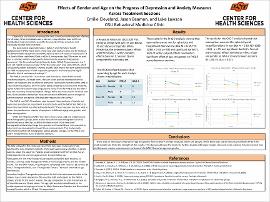| dc.contributor.author | Cleveland, Emilie | |
| dc.contributor.author | Beaman, Jason | |
| dc.contributor.author | Lawson, Luke | |
| dc.date.accessioned | 2023-11-02T20:44:07Z | |
| dc.date.available | 2023-11-02T20:44:07Z | |
| dc.date.issued | 2023-02-17 | |
| dc.identifier | ouhd_Cleveland_effectsofgenderandage_2023 | |
| dc.identifier.citation | Cleveland, E., Beaman, J., and Lawson, L. (2023, February 17). Effects of gender and age on the progress of depression and anxiety measures across treatment sessions. Poster presented at Research Week, Oklahoma State University Center for Health Sciences, Tulsa, Ok. | |
| dc.identifier.uri | https://hdl.handle.net/11244/339875 | |
| dc.description.abstract | Background: Depression and anxiety are among the most common disorders affecting the U.S. population. They can severely impact an individual’s daily life, which causes them to seek treatment. Treatment centers will use surveys to quantify the severity of the symptoms and monitor it across appointments to track progress. The standardized tools to measure anxiety and depression are the General Anxiety Disorder 7 (GAD-7) and the Patient Health Questionnaire-9 (PHQ-9), respectively. Depression and anxiety have broad symptoms and effects depending on the patient’s demographics, such as gender and age. This study will analyze the relationship between these groups and the change in survey responses between treatment sessions. | |
| dc.description.abstract | Aim: This study is focused on determining the effects of age and gender on the change in depression and anxiety measurements between treatment sessions. | |
| dc.description.abstract | Methods: A secondary analysis will be conducted on a dataset of 81 newly admitted patients to the OSU Behavioral Medicine Clinic: 41 completed the PHQ-9, and 40 completed the GAD-7 at their initial visit and follow-up appointment, approximately a month later. The GAD-7 and PHQ-9 produce a quantitative representation of the severity of symptoms based on self-rated questions for each disorder. A two-way mixed factorial ANOVA with factors of gender (male, female) and age (35 and below, 36 and above). | |
| dc.description.abstract | Results and Conclusion: Results will be reported after the completion of data analysis. Conclusions are also pending analyses. Understanding the differences between these demographic groups in the changes in symptoms between sessions is essential due to the widespread effects of these disorders and how the disorders vary based on experiences, which means treatment will also be. This study will assist in better understanding these disorders and insight into how age and gender can affect anxiety and depression symptoms. | |
| dc.format | application/pdf | |
| dc.language | en_US | |
| dc.publisher | Oklahoma State University Center for Health Sciences | |
| dc.rights | The author(s) retain the copyright or have the right to deposit the item giving the Oklahoma State University Library a limited, non-exclusive right to share this material in its institutional repository. Contact Digital Resources and Discovery Services at lib-dls@okstate.edu or 405-744-9161 for the permission policy on the use, reproduction or distribution of this material. | |
| dc.title | Effects of gender and age on the progress of depression and anxiety measures across treatment sessions | |
| osu.filename | ouhd_Cleveland_effectsofgenderandage_2023.pdf | |
| dc.type.genre | Presentation | |
| dc.type.material | Text | |
| dc.subject.keywords | depression | |
| dc.subject.keywords | anxiety | |
| dc.subject.keywords | demographic factors | |
